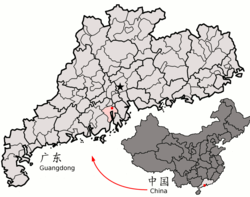This article has multiple issues. Please help improve it or discuss these issues on the talk page . (Learn how and when to remove these messages)
|
Xinhui 新会区 Sunwui; Hsinhui | |||||||||||||||||||||||
|---|---|---|---|---|---|---|---|---|---|---|---|---|---|---|---|---|---|---|---|---|---|---|---|
 | |||||||||||||||||||||||
| Motto: Realistic, innovative | |||||||||||||||||||||||
 Xinhui District (red) within Guangdong | |||||||||||||||||||||||
| Coordinates: 22°31′41″N113°01′52″E / 22.5281°N 113.031°E | |||||||||||||||||||||||
| Country | China | ||||||||||||||||||||||
| Province | Guangdong | ||||||||||||||||||||||
| Prefecture-level city | Jiangmen | ||||||||||||||||||||||
| Area | |||||||||||||||||||||||
| 1,354.7149 km2 (523.0583 sq mi) | |||||||||||||||||||||||
| • Land | 1,075.24 km2 (415.15 sq mi) | ||||||||||||||||||||||
| • Water | 279.48 km2 (107.91 sq mi) | ||||||||||||||||||||||
| • Urban | 143.8698 km2 (55.5484 sq mi) | ||||||||||||||||||||||
| Dimensions | |||||||||||||||||||||||
| • Length | 54.5 km (33.9 mi) | ||||||||||||||||||||||
| • Width | 48.8 km (30.3 mi) | ||||||||||||||||||||||
| Population (2016) | |||||||||||||||||||||||
| 757,988 | |||||||||||||||||||||||
| • Density | 704.948/km2 (1,825.81/sq mi) | ||||||||||||||||||||||
| • Urban | 757,988 | ||||||||||||||||||||||
| • Urban density | 5,268.57/km2 (13,645.5/sq mi) | ||||||||||||||||||||||
| Time zone | UTC+8 (China Standard) | ||||||||||||||||||||||
| Postal code | 529100-529159 | ||||||||||||||||||||||
| Area code | (0)750 | ||||||||||||||||||||||
| Vehicle registration | 粤JK 粤JL 粤JM 粤JN 粤JO | ||||||||||||||||||||||
| Website | www | ||||||||||||||||||||||
| Xinhui | |||||||||||||||||||||||
| Simplified Chinese | 新会 | ||||||||||||||||||||||
| Traditional Chinese | 新會 | ||||||||||||||||||||||
| Postal | Sunwui | ||||||||||||||||||||||
| |||||||||||||||||||||||
| Kuixiang (former) | |||||||||||||||||||||||
| Simplified Chinese | 葵乡 | ||||||||||||||||||||||
| Traditional Chinese | 葵鄉 | ||||||||||||||||||||||
| |||||||||||||||||||||||
| Gugangzhou (former) | |||||||||||||||||||||||
| Simplified Chinese | 古冈州 | ||||||||||||||||||||||
| Traditional Chinese | 古岡州 | ||||||||||||||||||||||
| Literal meaning | Old Ridge Prefecture | ||||||||||||||||||||||
| |||||||||||||||||||||||
Xinhui,alternately romanized as Sunwui [a] and also known as Kuixiang,is an urban district of Jiangmen in Guangdong,China. It grew from a separate city founded at the confluence of the Tan and West Rivers. It has a population of about 735,500,[ when? ] 98% of whom are Han Chinese and many of them speak a dialect of Cantonese as their first language. Xinhui is best known in China for its chenpi ,a kind of dried Mandarin orange peel.